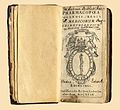Pharmacopoeia
Pharmacopoeia (also spelled pharmacopeia) is a book containing directions for the identification of compound medicines, and published by the authority of a government or a medical or pharmaceutical society.
Description
In a broader sense, it is a reference work for pharmaceutical drug specifications. It includes texts on the page named Monograph that describes an individual drug. The term might also refer to a stock of an apothecary's shop.
History
The concept of pharmacopoeia has its origins in the ancient times, as a form of standardization and quality control for medicines. The first known pharmacopoeia was written in the 1st century AD by Pedanius Dioscorides, a Greek physician. The word derives from the Greek, pharmacon (meaning "drug") and poiein (meaning "to make").
Modern Pharmacopoeias
Today, several nations have their own pharmacopoeia, and there are also international pharmacopoeias such as the European Pharmacopoeia.
National Pharmacopoeias
- British Pharmacopoeia
- United States Pharmacopeia
- Japanese Pharmacopoeia
- Pharmacopoeia of the People's Republic of China
International Pharmacopoeias
See also
Transform your life with W8MD's budget GLP-1 injections from $125.
W8MD offers a medical weight loss program to lose weight in Philadelphia. Our physician-supervised medical weight loss provides:
- Most insurances accepted or discounted self-pay rates. We will obtain insurance prior authorizations if needed.
- Generic GLP1 weight loss injections from $125 for the starting dose.
- Also offer prescription weight loss medications including Phentermine, Qsymia, Diethylpropion, Contrave etc.
NYC weight loss doctor appointments
Start your NYC weight loss journey today at our NYC medical weight loss and Philadelphia medical weight loss clinics.
- Call 718-946-5500 to lose weight in NYC or for medical weight loss in Philadelphia 215-676-2334.
- Tags:NYC medical weight loss, Philadelphia lose weight Zepbound NYC, Budget GLP1 weight loss injections, Wegovy Philadelphia, Wegovy NYC, Philadelphia medical weight loss, Brookly weight loss and Wegovy NYC
|
WikiMD's Wellness Encyclopedia |
| Let Food Be Thy Medicine Medicine Thy Food - Hippocrates |
Medical Disclaimer: WikiMD is not a substitute for professional medical advice. The information on WikiMD is provided as an information resource only, may be incorrect, outdated or misleading, and is not to be used or relied on for any diagnostic or treatment purposes. Please consult your health care provider before making any healthcare decisions or for guidance about a specific medical condition. WikiMD expressly disclaims responsibility, and shall have no liability, for any damages, loss, injury, or liability whatsoever suffered as a result of your reliance on the information contained in this site. By visiting this site you agree to the foregoing terms and conditions, which may from time to time be changed or supplemented by WikiMD. If you do not agree to the foregoing terms and conditions, you should not enter or use this site. See full disclaimer.
Credits:Most images are courtesy of Wikimedia commons, and templates, categories Wikipedia, licensed under CC BY SA or similar.
Contributors: Prab R. Tumpati, MD



